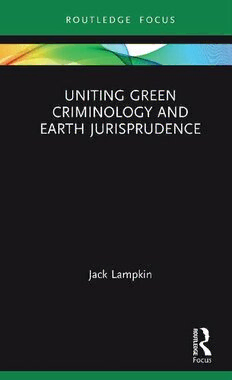
Uniting Green Criminology and Earth Jurisprudence PDF
Preview Uniting Green Criminology and Earth Jurisprudence
Uniting Green Criminology and Earth Jurisprudence A s planet Earth continues to absorb unprecedented levels of anthropogenically induced environmental and climatic change, two similar academic schools of thought have emerged in recent years, both making sustained efforts to explain how and why this state of affairs has evolved. These two disciplines are known as green criminology and earth jurisprudence . Whilst these areas of study can be seen as sub-disciplines of their parent subjects, law and criminology, this book proposes that much can be achieved by authors uniting and collaborating on their academic work. By doing this, it is argued that green criminology stands to benefit from a discipline that places mother nature at the heart of lawmaking and therefore providing a solution to the environmental harms identified by green criminologists. Furthermore, earth jurisprudence will profit from utilising the breadth of academic work produced within the green criminology academic arena. Therefore, this book seeks to unite green criminology and earth jurisprudence in an effort to find solutions to the extraordinary environmental problems that the world now faces. Dr. Jack Lampkin is a Lecturer in Policing at Teesside University. He obtained his PhD in 2018 from the University of Lincoln’s Law School and has several academic publications in the field of green criminology. ‘Combining the insights of green criminology and earth jurisprudence, this energising and thought-provoking book offers an invitation to think hard and act fast – a vital task for the times. It provides an intellectual gateway to understanding and responding to the environmental crises threatening our planet, thereby offering conceptual direction to struggles past, present and future. ’ Professor Rob White, University of Tasmania, Australia Uniting Green Criminology and Earth Jurisprudence Jack Lampkin First published 2021 by Routledge 2 Park Square, Milton Park, Abingdon, Oxon OX14 4RN and by Routledge 52 Vanderbilt Avenue, New York, NY 10017 Routledge is an imprint of the Taylor & Francis Group, an informa business © 2021 Jack Lampkin The right of Jack Lampkin to be identified as of this work has been asserted by him in accordance with sections 77 and 78 of the Copyright, Designs and Patents Act 1988. All rights reserved. No part of this book may be reprinted or reproduced or utilised in any form or by any electronic, mechanical, or other means, now known or hereafter invented, including photocopying and recording, or in any information storage or retrieval system, without permission in writing from the publishers. Trademark notice : Product or corporate names may be trademarks or registered trademarks, and are used only for identification and explanation without intent to infringe. British Library Cataloguing-in-Publication Data A catalogue record for this book is available from the British Library Library of Congress Cataloging-in-Publication Data A catalog record for this book has been requested ISBN: 978-0-367-61306-8 (hbk) ISBN: 978-1-003-10513-8 (ebk) Typeset in Times New Roman by Apex CoVantage, LLC For Bethany Contents List of tables viii Foreword ix Acknowledgements xi List of abbreviations xii 1 Introduction to issues of global environmental harm 1 2 Historical and theoretical foundations of a ‘green’ criminology 13 3 Historical and theoretical foundations of an earth jurisprudence 29 4 Uniting green criminology and earth jurisprudence 49 5 Earth jurisprudence in practice: success stories 65 6 Concluding thoughts 77 References 82 Index 96 Tables 2.1 The Spectrum of Green Criminological Research 23 2.2 Debates Surrounding the Limitations of Green Criminology 25 3.1 Principles of Earth Jurisprudence 31 3.2 Six Major Criticisms of Earth Jurisprudence 40 4.1 The Benefits of Uniting Green Criminology and Earth Jurisprudence 62 Foreword The Earth faces environmental crises from many angles. Climate change and the chaos it will bring are already upon us and will worsen in the coming years. Pollution from plastics and from pesticides, fertilisers, insecticides, and so forth plagues the oceans and the soil. Our fellow non-human inhabitants are dying and being killed at an unprecedented rate. And further billions of non-humans live in abhorrent conditions and endure pain-filled, short lives. At the same time, a tiny proportion of humanity is richer in terms of wealth and material possessions than ever before. Corporations, too, have reached immense levels of wealth and power. Even ‘everyday’ people in the West and North consume at environmentally damaging levels. At the heart of this environmental devastation are societies centred on the (individual) human. Urgent changes and improvements are needed for both the planet and all those who live on it. In step green criminology and earth jurisprudence. These radical, critical subfields of criminology and law challenge the human centeredness – anthropocentrism – of most of the world. And although they both emerged in the 1990s and champion quite similar beliefs, nearly no synthesis of the two environmentally minded subfields has been attempted. Thus, U niting Green Criminology and Earth Jurisprudence is an exciting and valuable undertaking. The book opens by setting the stage on the state of the environment. In particular, Jack focuses on deforestation, biodiversity loss, non-human animal use and abuse for food, and plastic pollution. All of these areas provide rich examples of harms that are mostly legal, and the examples highlight that the legal system supports and perpetuates environmental devastation. The fact that environmental harm and legality are often inextricably intertwined provides a solid foundation for why green criminology and earth jurisprudence should be united. Jack then goes on to detail the historical and theoretical foundations of, first, green criminology and then earth jurisprudence. These chapters
